Navigating climate change can feel overwhelming, but local initiatives are making a tangible difference. SIXT.VN is committed to connecting you with sustainable travel options, highlighting how communities in Vietnam and beyond are adapting. By understanding these grassroots efforts, you can support responsible tourism and contribute to a greener future for your Vietnam travel experience. These include community-based tourism, eco-tourism practices, and local conservation projects.
1. What is Climate Change Adaptation at the Local Level?
Climate change adaptation at the local level refers to the strategies and actions that communities, cities, and regions undertake to reduce their vulnerability to the impacts of climate change. It involves adjusting to current or expected effects of climate change. According to the United Nations Framework Convention on Climate Change (UNFCCC), adaptation aims to lower risks from the effects of climate change.
Adaptation measures can range from infrastructure improvements and technological solutions to changes in behavior and policy. For example, coastal communities might build sea walls or restore mangrove forests to protect against rising sea levels, while farmers might adopt drought-resistant crops or implement water conservation techniques. Local initiatives often prioritize community involvement, traditional knowledge, and sustainable development practices to ensure that adaptation efforts are effective, equitable, and culturally appropriate.
2. Why are Local Initiatives Important for Climate Change Adaptation?
Local initiatives are crucial for effective climate change adaptation because they address specific regional needs and vulnerabilities. These initiatives often incorporate local knowledge and community participation, leading to more sustainable and equitable outcomes. According to a report by the Intergovernmental Panel on Climate Change (IPCC) in 2022, locally led adaptation is more effective in reducing risks and vulnerabilities.
Local initiatives are tailored to the unique environmental, social, and economic contexts of a region. They are often more flexible and responsive than top-down approaches. They foster community ownership and resilience. They empower local populations to take control of their future. For tourists, supporting these initiatives means contributing directly to the well-being of the communities they visit, promoting sustainable tourism practices.
3. What Types of Local Initiatives Address Climate Change Adaptation?
Many local initiatives address climate change adaptation in diverse ways, focusing on specific regional challenges. These can be broadly categorized into several types:
3.1. Infrastructure Improvements
These projects aim to enhance the resilience of physical structures and systems to climate-related hazards.
- Construction of Sea Walls and Flood Barriers: Protecting coastal communities from rising sea levels and storm surges.
- Upgrading Drainage Systems: Improving stormwater management to reduce the risk of flooding in urban areas.
- Building Climate-Resilient Roads and Bridges: Ensuring transportation infrastructure can withstand extreme weather events.
3.2. Ecosystem-Based Adaptation
These approaches harness the power of natural ecosystems to provide adaptation benefits.
- Restoring Mangrove Forests: Providing natural coastal protection, supporting biodiversity, and sequestering carbon.
- Reforestation and Afforestation Projects: Enhancing water regulation, preventing soil erosion, and creating habitats.
- Protecting and Restoring Wetlands: Acting as natural sponges to absorb floodwaters and buffer against droughts.
3.3. Agricultural Adaptations
These initiatives focus on helping farmers adapt to changing climate conditions and ensure food security.
- Promoting Drought-Resistant Crops: Enabling farmers to grow food in water-scarce environments.
- Implementing Water Conservation Techniques: Utilizing efficient irrigation methods and rainwater harvesting to conserve water resources.
- Diversifying Farming Systems: Reducing reliance on single crops and enhancing resilience to climate shocks.
3.4. Community-Based Adaptation
These approaches empower local communities to develop and implement their own adaptation strategies.
- Establishing Early Warning Systems: Providing timely information about impending climate-related hazards.
- Conducting Vulnerability Assessments: Identifying the most vulnerable populations and sectors within a community.
- Developing Local Adaptation Plans: Creating roadmaps for building resilience based on community needs and priorities.
3.5. Policy and Governance
These initiatives involve changes to regulations, policies, and governance structures to support adaptation efforts.
- Integrating Climate Change into Land Use Planning: Ensuring that new developments are resilient to climate risks.
- Establishing Climate Change Adaptation Funds: Providing financial resources for local adaptation projects.
- Strengthening Institutional Capacity: Building the expertise and resources of local governments to address climate change.
4. What are Some Examples of Successful Local Climate Change Adaptation Initiatives?
Numerous communities worldwide have implemented successful local climate change adaptation initiatives, showcasing the effectiveness of grassroots efforts. Some notable examples include:
4.1. Bangladesh: Floating Gardens
In Bangladesh, farmers are using floating gardens to adapt to frequent flooding. These gardens are created by layering aquatic plants and organic matter on bamboo rafts, allowing farmers to grow crops even when land is submerged. According to the Food and Agriculture Organization (FAO), this innovative technique has helped to improve food security and livelihoods in flood-prone areas.
4.2. Netherlands: Room for the River
The Netherlands has implemented the “Room for the River” program to manage flood risks. This initiative involves widening river channels, creating overflow areas, and restoring natural floodplains to accommodate excess water during heavy rainfall. According to Rijkswaterstaat, the program has significantly reduced the risk of flooding for millions of people.
4.3. Kenya: Community-Based Water Management
In Kenya, communities are implementing community-based water management strategies to cope with droughts. These strategies include constructing sand dams to capture and store rainwater, promoting water-efficient farming practices, and establishing water user associations to manage water resources sustainably. A study by the United Nations Environment Programme (UNEP) found that these initiatives have improved water availability and resilience to drought.
4.4. Vietnam: Mangrove Restoration
Vietnam has successfully restored mangrove forests along its coastlines to protect against storm surges and erosion. These mangrove forests act as natural barriers, reducing the impact of waves and wind on coastal communities. According to the Mangrove Action Project, this initiative has not only protected shorelines but also provided habitat for marine life and supported local fisheries.
4.5. India: Rainwater Harvesting
In India, many communities are adopting rainwater harvesting techniques to address water scarcity. This involves collecting rainwater from rooftops and other surfaces and storing it for later use. According to the Centre for Science and Environment (CSE), rainwater harvesting has helped to recharge groundwater aquifers, improve water availability, and reduce reliance on external water sources.
5. How Can Tourists Support Local Climate Change Adaptation Initiatives in Vietnam?
As a tourist in Vietnam, you can play a significant role in supporting local climate change adaptation initiatives. Your choices and actions can contribute to the sustainability and resilience of the communities you visit. Here are several ways to support these initiatives:
5.1. Choose Eco-Friendly Accommodation
Opt for hotels and guesthouses that prioritize sustainability and environmental responsibility. Look for accommodations that have implemented energy-efficient technologies, water conservation measures, and waste reduction programs. Many eco-lodges in Vietnam also support local conservation efforts and community development projects.
5.2. Participate in Community-Based Tourism
Engage in community-based tourism activities that directly benefit local communities. These activities can include staying in homestays, taking guided tours led by local residents, and purchasing locally made products. Community-based tourism helps to generate income for local families, preserve cultural heritage, and promote environmental conservation.
5.3. Support Local Businesses
Patronize local restaurants, markets, and shops that source their products and ingredients from local farmers and artisans. This helps to support local economies, reduce carbon emissions associated with transportation, and promote sustainable agricultural practices. Look for businesses that prioritize fair trade and ethical sourcing.
5.4. Reduce Your Carbon Footprint
Minimize your carbon footprint by choosing sustainable transportation options, such as walking, cycling, or using public transportation. When possible, opt for direct flights to reduce emissions associated with air travel. Consider offsetting your carbon emissions by donating to reputable carbon offset programs that support renewable energy and reforestation projects in Vietnam.
5.5. Respect Local Environment and Culture
Respect the local environment and culture by following responsible tourism practices. Avoid littering, stay on marked trails, and refrain from disturbing wildlife. Learn about local customs and traditions and be mindful of your behavior. Support conservation efforts by participating in clean-up activities or donating to local environmental organizations.
5.6. Educate Yourself and Others
Take the time to educate yourself about climate change adaptation initiatives in Vietnam and share your knowledge with others. Talk to local residents, visit eco-tourism sites, and learn about the challenges and opportunities facing communities in the face of climate change. Encourage your friends and family to support sustainable tourism practices and contribute to local conservation efforts.
6. What are the Challenges to Implementing Local Climate Change Adaptation Initiatives?
Implementing local climate change adaptation initiatives faces several challenges that can hinder their effectiveness and sustainability. Addressing these challenges is crucial for ensuring that local adaptation efforts are successful in building resilience to climate change impacts. Some of the main challenges include:
6.1. Limited Financial Resources
Many local communities lack the financial resources needed to implement adaptation projects. This can be due to limited access to funding, competing priorities, and inadequate financial management capacity. Securing adequate funding is essential for supporting local adaptation initiatives and ensuring their long-term sustainability.
6.2. Lack of Technical Expertise
Local communities may lack the technical expertise needed to design and implement effective adaptation strategies. This can include a lack of knowledge about climate change impacts, vulnerability assessments, and adaptation technologies. Providing technical assistance and capacity building is crucial for empowering local communities to address climate change challenges.
6.3. Inadequate Institutional Support
Local governments and institutions may lack the capacity and resources needed to support adaptation efforts. This can include a lack of coordination, inadequate policy frameworks, and limited enforcement of regulations. Strengthening institutional support is essential for creating an enabling environment for local adaptation.
6.4. Limited Community Participation
Adaptation initiatives may fail if they do not adequately involve local communities in the planning and implementation process. This can lead to a lack of ownership, resistance to change, and ineffective outcomes. Ensuring meaningful community participation is crucial for developing adaptation strategies that are relevant, equitable, and sustainable.
6.5. Uncertainties and Risks
Climate change impacts are often uncertain and unpredictable, making it difficult to plan and implement adaptation measures. This can lead to maladaptation, where adaptation efforts inadvertently increase vulnerability to climate change. Managing uncertainties and risks requires flexible and adaptive approaches that can be adjusted as new information becomes available.
7. How Can SIXT.VN Support Sustainable Tourism and Climate Change Adaptation in Vietnam?
SIXT.VN is committed to promoting sustainable tourism and supporting climate change adaptation efforts in Vietnam. By offering convenient and reliable travel services, SIXT.VN aims to make it easier for tourists to explore Vietnam in a responsible and environmentally conscious manner. Here are several ways SIXT.VN supports sustainable tourism and climate change adaptation:
7.1. Eco-Friendly Transportation Options
SIXT.VN offers a range of eco-friendly transportation options, including hybrid and electric vehicles, to help reduce carbon emissions associated with travel. Customers can choose these options when booking their transportation services, contributing to a greener and more sustainable tourism industry.
7.2. Partnerships with Sustainable Accommodation Providers
SIXT.VN partners with hotels and guesthouses that prioritize sustainability and environmental responsibility. These accommodations have implemented energy-efficient technologies, water conservation measures, and waste reduction programs. By promoting these accommodations, SIXT.VN encourages tourists to support sustainable tourism practices.
7.3. Promotion of Community-Based Tourism
SIXT.VN promotes community-based tourism activities that directly benefit local communities. These activities include staying in homestays, taking guided tours led by local residents, and purchasing locally made products. By supporting community-based tourism, SIXT.VN helps to generate income for local families, preserve cultural heritage, and promote environmental conservation.
7.4. Support for Local Conservation Efforts
SIXT.VN supports local conservation efforts by partnering with environmental organizations and initiatives. This can include donating a portion of its profits to conservation projects, promoting responsible tourism practices, and raising awareness about climate change adaptation challenges.
7.5. Education and Awareness Campaigns
SIXT.VN conducts education and awareness campaigns to inform tourists about sustainable tourism practices and climate change adaptation issues. These campaigns can include providing information about eco-friendly transportation options, promoting responsible tourism behaviors, and highlighting the importance of supporting local communities and conservation efforts.
8. What are the Policy Implications for Local Climate Change Adaptation?
Effective local climate change adaptation requires supportive policies and governance structures at all levels. Policy implications for local adaptation involve creating an enabling environment for communities to develop and implement their own adaptation strategies. Key policy considerations include:
8.1. Mainstreaming Climate Change into Development Planning
Integrate climate change considerations into all aspects of development planning, including land use, infrastructure, and economic development. This ensures that new developments are climate-resilient and do not exacerbate existing vulnerabilities. According to the World Bank, mainstreaming climate change into development planning can lead to more effective and sustainable outcomes.
8.2. Decentralizing Climate Finance
Ensure that financial resources for climate change adaptation are accessible to local communities and governments. This may involve establishing dedicated climate funds, streamlining application processes, and providing technical assistance to support project development. A report by the Global Commission on Adaptation recommends decentralizing climate finance to empower local actors.
8.3. Strengthening Local Governance
Empower local governments and institutions to play a leading role in adaptation planning and implementation. This may involve providing training, resources, and technical assistance to build local capacity. The United Nations Development Programme (UNDP) emphasizes the importance of strengthening local governance for effective climate change adaptation.
8.4. Promoting Community Participation
Involve local communities in all stages of adaptation planning and implementation. This ensures that adaptation strategies are relevant, equitable, and sustainable. The Intergovernmental Panel on Climate Change (IPCC) highlights the importance of community participation for successful adaptation outcomes.
8.5. Establishing Monitoring and Evaluation Systems
Develop systems for monitoring and evaluating the effectiveness of adaptation measures. This allows for adaptive management and continuous improvement. The Global Environment Facility (GEF) recommends establishing robust monitoring and evaluation systems to track progress and identify lessons learned.
9. What Role Does Technology Play in Local Climate Change Adaptation Initiatives?
Technology plays a crucial role in enhancing the effectiveness and scalability of local climate change adaptation initiatives. From early warning systems to precision agriculture, technological innovations offer powerful tools for building resilience and reducing vulnerability to climate change impacts. Some key applications of technology in local adaptation include:
9.1. Early Warning Systems
Advanced sensor technologies, satellite imagery, and data analytics are used to develop early warning systems for climate-related hazards such as floods, droughts, and heatwaves. These systems provide timely information to communities, enabling them to take proactive measures to protect themselves and their assets. The World Meteorological Organization (WMO) supports the development and deployment of early warning systems worldwide.
9.2. Precision Agriculture
Precision agriculture technologies, such as drones, sensors, and data analytics, are used to optimize farming practices and improve water management in agriculture. These technologies enable farmers to monitor soil conditions, crop health, and weather patterns, allowing them to make informed decisions about irrigation, fertilization, and pest control. According to a report by the Food and Agriculture Organization (FAO), precision agriculture can significantly increase crop yields and reduce water consumption.
9.3. Water Management Technologies
Innovative water management technologies, such as smart irrigation systems, rainwater harvesting systems, and water purification systems, are used to improve water availability and efficiency in water-scarce regions. These technologies enable communities to conserve water resources, reduce water losses, and ensure access to safe drinking water. The International Water Management Institute (IWMI) promotes the use of technology for sustainable water management.
9.4. Climate-Resilient Infrastructure
Advanced materials and construction techniques are used to build climate-resilient infrastructure that can withstand extreme weather events. This includes constructing sea walls, flood barriers, and climate-resilient roads and bridges. The World Bank supports investments in climate-resilient infrastructure to protect communities and economies from climate change impacts.
9.5. Remote Sensing and GIS
Remote sensing technologies and geographic information systems (GIS) are used to monitor environmental conditions, assess vulnerabilities, and map climate risks. These technologies provide valuable data and insights for adaptation planning and decision-making. The United Nations Environment Programme (UNEP) utilizes remote sensing and GIS for environmental monitoring and assessment.
10. What is the Future of Local Climate Change Adaptation Initiatives?
The future of local climate change adaptation initiatives is promising, with increasing recognition of the importance of community-led approaches and the potential for scaling up successful models. Key trends and developments shaping the future of local adaptation include:
10.1. Increased Funding and Investment
Growing awareness of the need for climate change adaptation is leading to increased funding and investment in local adaptation initiatives. Governments, international organizations, and private sector actors are recognizing the importance of supporting community-led efforts to build resilience to climate change impacts. The Green Climate Fund (GCF) provides financial resources for adaptation projects in developing countries.
10.2. Scaling Up Successful Models
Successful local adaptation initiatives are being scaled up and replicated in other regions and contexts. This involves sharing knowledge, best practices, and lessons learned, as well as providing technical assistance and capacity building to support implementation. The Global Center on Adaptation (GCA) promotes the scaling up of successful adaptation models worldwide.
10.3. Integration with Sustainable Development Goals
Local climate change adaptation initiatives are increasingly being integrated with the Sustainable Development Goals (SDGs). This recognizes the interconnectedness of climate change, poverty, inequality, and other development challenges. The United Nations Sustainable Development Goals (SDGs) provide a framework for addressing these challenges in an integrated and holistic manner.
10.4. Enhanced Monitoring and Evaluation
Greater emphasis is being placed on monitoring and evaluating the effectiveness of local adaptation initiatives. This allows for adaptive management, continuous improvement, and evidence-based decision-making. The Global Environment Facility (GEF) recommends establishing robust monitoring and evaluation systems to track progress and identify lessons learned.
10.5. Community Empowerment and Participation
The future of local climate change adaptation is centered on empowering communities to take control of their own resilience. This involves providing access to information, resources, and decision-making processes, as well as recognizing and valuing local knowledge and traditional practices. The Intergovernmental Panel on Climate Change (IPCC) highlights the importance of community empowerment for successful adaptation outcomes.
By understanding and supporting local climate change adaptation initiatives, you can contribute to a more sustainable and resilient future for Vietnam and the world. SIXT.VN is here to help you explore Vietnam responsibly, connecting you with eco-friendly transportation options and promoting sustainable tourism practices.
Are you ready to explore Vietnam responsibly and support local climate change adaptation initiatives? Visit SIXT.VN today to book your eco-friendly transportation and discover sustainable tourism options!
Contact Information:
Address: 260 Cau Giay, Hanoi, Vietnam
Hotline/Whatsapp: +84 986 244 358
Website: SIXT.VN
FAQ: Local Climate Change Adaptation Initiatives
1. What is local climate change adaptation?
Local climate change adaptation involves strategies and actions taken by communities to reduce vulnerability to climate change impacts, addressing specific regional needs.
2. Why are local initiatives important for climate change adaptation?
They address specific regional needs, incorporate local knowledge, and foster community ownership, leading to more sustainable and equitable outcomes.
3. What are some examples of local climate change adaptation initiatives?
Examples include building sea walls, restoring mangrove forests, promoting drought-resistant crops, and establishing early warning systems.
4. How can tourists support local climate change adaptation in Vietnam?
Tourists can choose eco-friendly accommodations, participate in community-based tourism, support local businesses, and reduce their carbon footprint.
5. What are the challenges to implementing local climate change adaptation initiatives?
Challenges include limited financial resources, lack of technical expertise, inadequate institutional support, and limited community participation.
6. What is the role of technology in local climate change adaptation initiatives?
Technology enhances the effectiveness of initiatives through early warning systems, precision agriculture, and improved water management.
7. What are the policy implications for local climate change adaptation?
Policy implications include mainstreaming climate change into development planning, decentralizing climate finance, and strengthening local governance.
8. How can SIXT.VN support sustainable tourism and climate change adaptation in Vietnam?
SIXT.VN offers eco-friendly transportation, partners with sustainable accommodations, and promotes community-based tourism.
9. What is the future of local climate change adaptation initiatives?
The future includes increased funding, scaling up successful models, integration with Sustainable Development Goals, and community empowerment.
10. How can communities overcome the challenge of limited financial resources for local adaptation projects?
Communities can seek funding from government programs, international organizations, and private sector investments, while also developing innovative financing mechanisms like community-based savings and revolving funds.
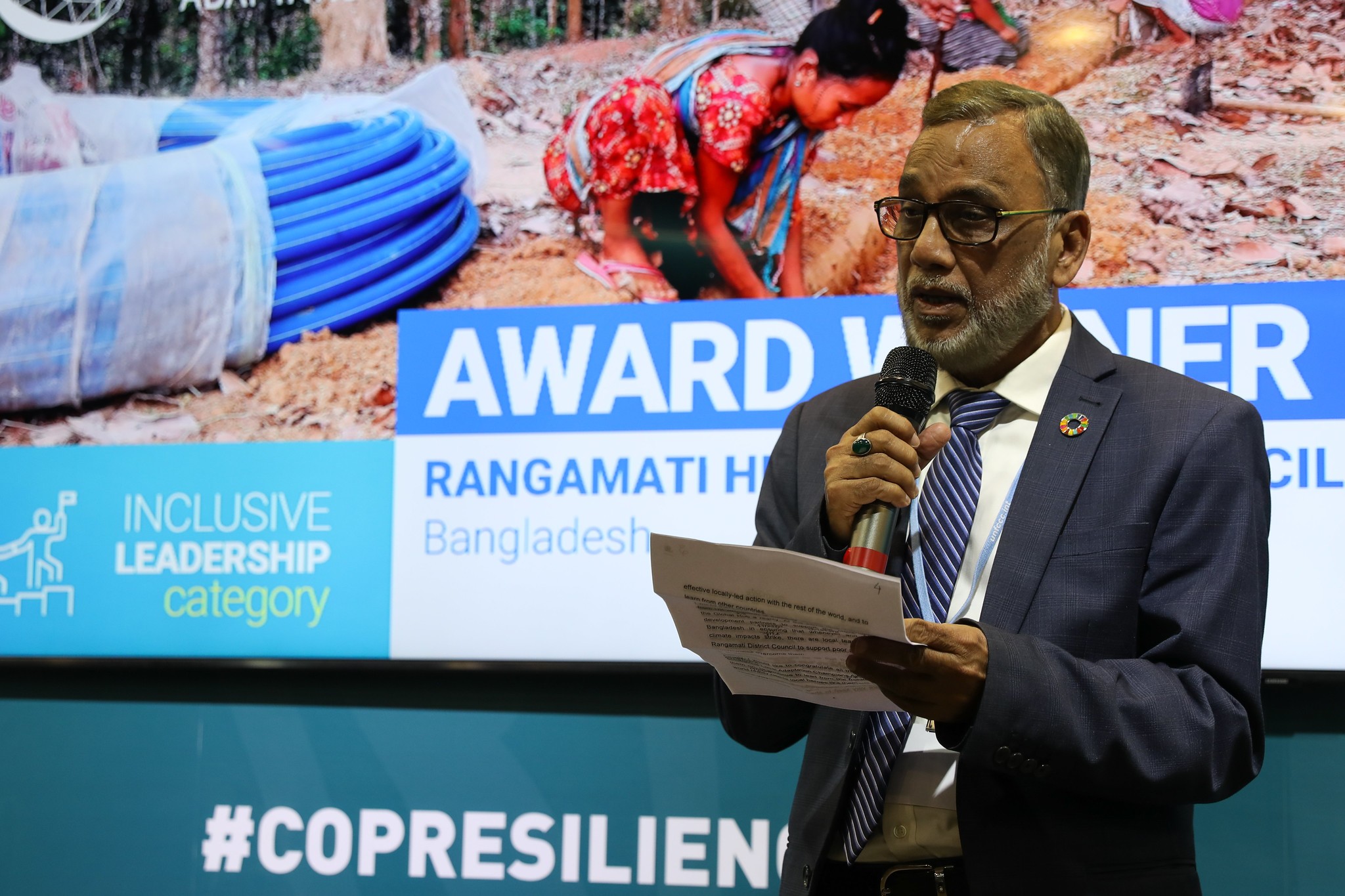 Floating gardens in Bangladesh, a locally-led climate change adaptation initiative
Floating gardens in Bangladesh, a locally-led climate change adaptation initiative
 COP26 Regional Ambassador to Asia-Pacific and South Asia speaking at an event highlighting the importance of locally-led adaptation
COP26 Regional Ambassador to Asia-Pacific and South Asia speaking at an event highlighting the importance of locally-led adaptation
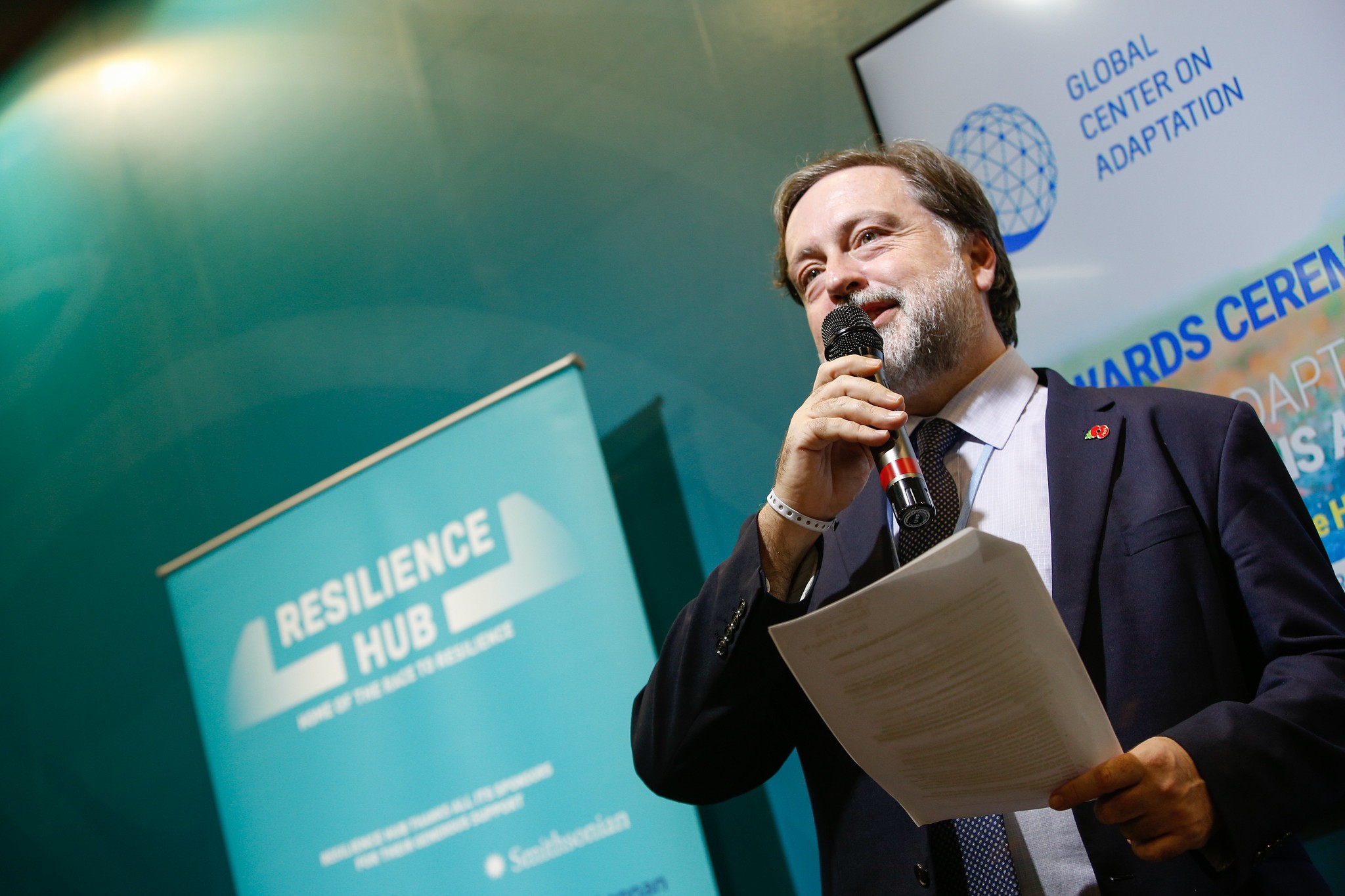 Group photo of award winners and organizers at the Local Adaptation Champions Awards ceremony
Group photo of award winners and organizers at the Local Adaptation Champions Awards ceremony
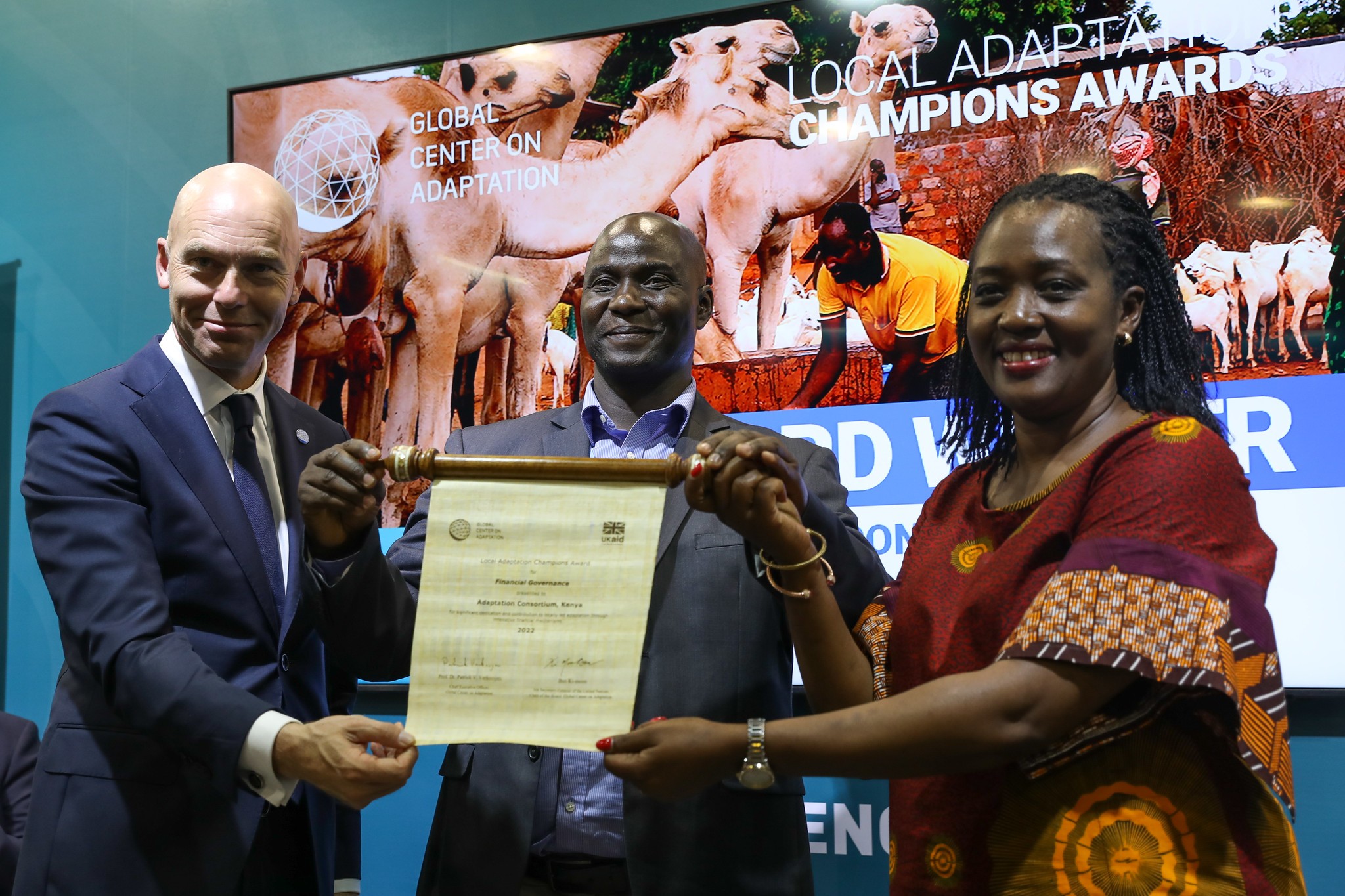 Victor Orindi, National Coordinator of the Adaptation Consortium, receives the award for financial governance
Victor Orindi, National Coordinator of the Adaptation Consortium, receives the award for financial governance
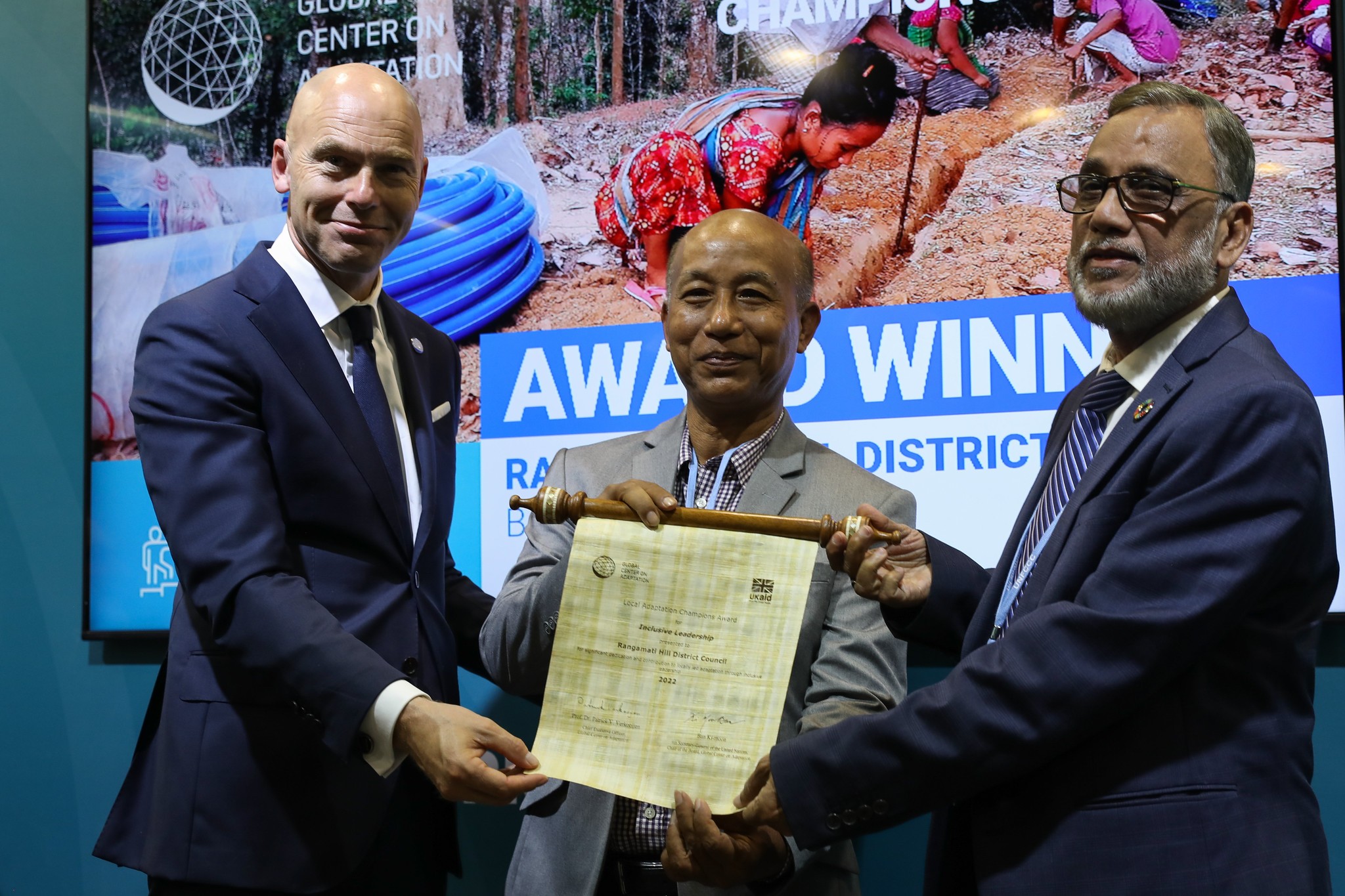 Arunendu Tripura, Public Relations Officer for Rangamati Hill District Council, discusses their inclusive leadership award
Arunendu Tripura, Public Relations Officer for Rangamati Hill District Council, discusses their inclusive leadership award
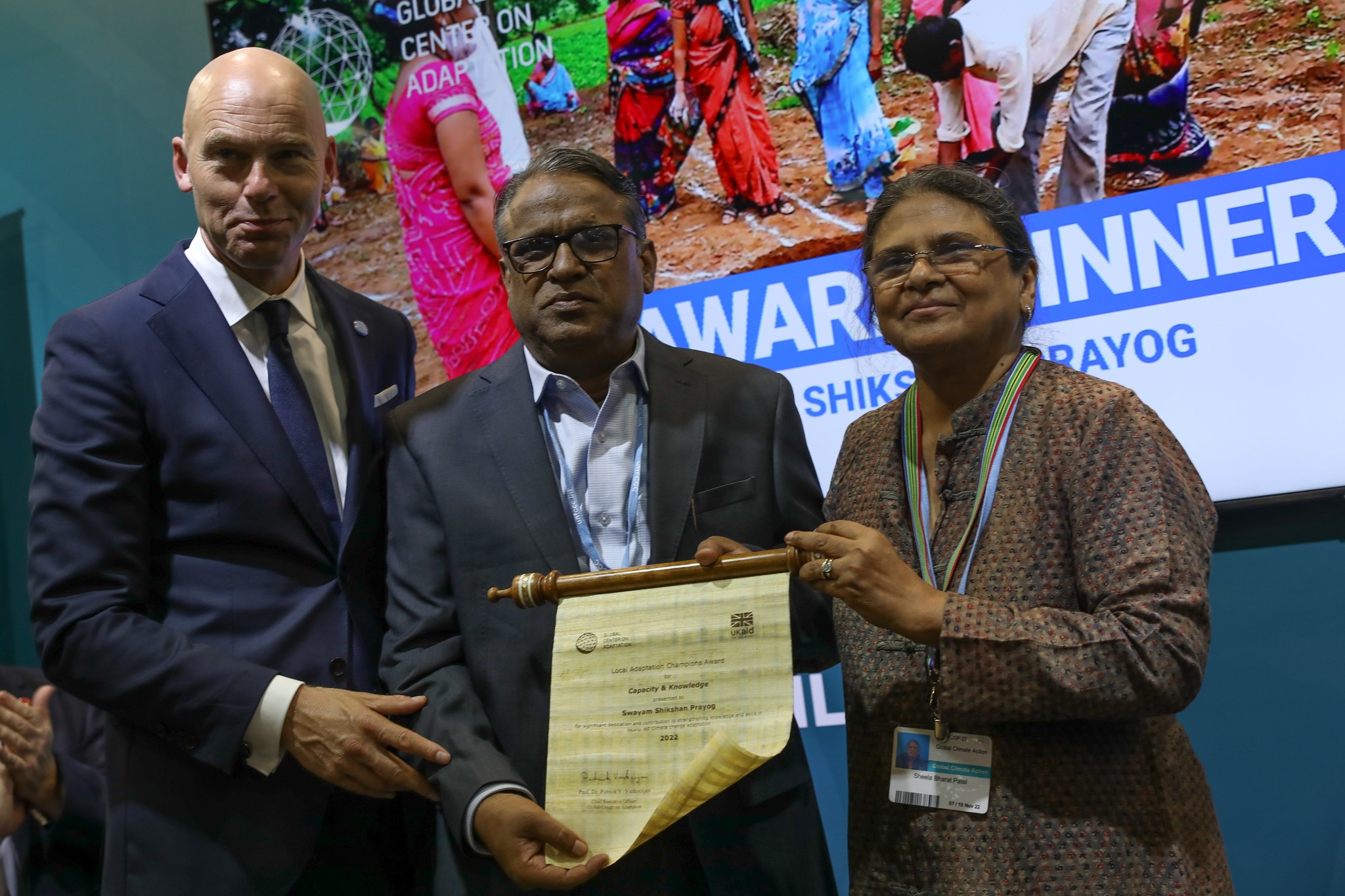 Upmanyu Patil, Director of Programs for Swayam Shikshan Prayog organization, accepts the award for capacity and knowledge
Upmanyu Patil, Director of Programs for Swayam Shikshan Prayog organization, accepts the award for capacity and knowledge



